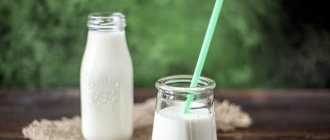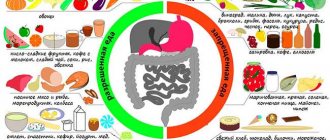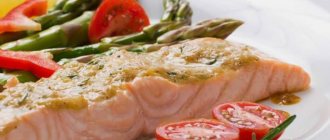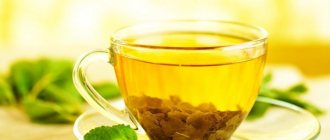In modern times, gastric diseases are quite often observed in people of different age groups. One of the causes of disruption of the stomach and the entire digestive system is chronic hypertrophic gastritis.
This pathology manifests itself in the growth of the gastric mucosa, as a result of which benign neoplasms, cysts, polyps, etc. are formed. In recent years, this disease has become common among people of all ages.
Causes
In the development of hypertrophic gastritis, an important role is played by the influence of harmful factors - external and internal. In some cases, the pathology is a consequence of the acute form, while in others it develops independently, as a result of prolonged and constant exposure to irritants.
Among them, prolonged consumption of alcoholic beverages, overeating, eating dry food, not chewing rough food well enough, hasty eating “on the go,” and poor dental condition are of great importance.
In addition, there are many factors that have a negative impact and lead to inflammation in the stomach:
- long breaks in eating (accompanied by the release of gastric juice, which corrodes the walls);
- smoking tobacco (impairs the secretory function of the stomach);
- insufficient content of complete proteins in the diet (lack of vitamins A, B, C impairs the function of the stomach and its ability to heal, leading to atrophy of the mucosa);
- long-term use of medications (salicylic, mercury drugs have an aggressive effect on the walls of the stomach);
- food allergies (food antigens irritate the walls and cause tissue swelling);
- circulatory disorders as a result of stress (insufficient oxygen supply in the blood).
Significant causes in the development and origin of hypertrophic gastritis are acute infectious diseases (tuberculosis, diphtheria, influenza, intestinal infections), as well as focal infections (sinusitis, tonsillitis, adnexitis).
Dysfunctions of the digestive organs (biliary tract, intestines, pancreas), as well as parasitic diseases (helminthiasis, trichocephalosis, ascariasis) are of great importance in the development of hypertrophic pathology.
It is necessary to note the professional causes of hypertrophic gastritis. For workers in hot shops and heavy industry, the disease occurs as a result of constant inhalation of toxic fumes - acids, mercury, ammonia.
It is important to know! Hypertrophic gastritis is a chronic form of the disease that affects men more than women. This is explained by the fact that the “strong half of humanity” is more susceptible to physical activity and bad habits - the use of tobacco and alcohol.
Classification
Diseases are divided into several types, depending on the duration and intensity of pathological processes. The main symptom that unites all forms is a change in the relief of the mucous membrane, against the background of secretory insufficiency. Under the influence of irritants, the mucous membrane becomes inflamed and regenerates (heals).
Continuous processes in the patient’s body lead to one of the forms of hypertrophic gastritis. Among gastroenterologists, a clinical classification is generally accepted, compiled taking into account data obtained from the use of modern research methods:
- warty type is a type of hypertrophic gastritis in which growths resembling papillomas form on the mucous membrane;
- Ménétrier's disease (giant gastritis) – the size of thickened folds of the mucous membrane reaches 3 cm, secretory glands atrophy, the number of mucus-forming glands increases;
- hypertrophic granular gastritis – characterized by the formation of small (less than 1 cm) growths;
- polypous appearance - characterized by the presence of single and multiple growths of connective tissue, from 0.5 to 2 cm in diameter, formed as a result of increased regeneration.
By their origin, growths in the stomach appear to be formations of different sizes. In some cases they are benign, and in others they are formations of severe inflammatory origin. Hypertrophic processes can spread into the parenchyma (muscle layers) of the walls.
Cystic cavities form and fill with mucus. Gradually, erosions (stomach ulcers) or hemorrhages (accumulation of blood in the tissues) form on the folds.
Treatment of hypertrophic gastritis with folk remedies is the most effective
Hypertrophic gastritis is a disease characterized by damage to the gastric mucosa. Most often, this form of gastritis is chronic. The result of such a lesion is an inflammatory process and painful sensations. Treatment of the presented illness can occur with the help of medications, proper nutrition and folk remedies.
Symptoms of hypertrophic gastritis can be found not only in the adult population. Sometimes the disease affects even young children. Hypertrophic gastritis can be distinguished from other forms of gastritis by the following symptoms:
For the prevention and treatment of gastritis and peptic ulcers, our readers recommend a proven gastric collection
from gastrointestinal diseases. Read the doctors' opinions. >>
- Painful sensations in the epigastric region that take on an aching character. The pain may occur intermittently and be replaced by cutting attacks.
- Heartburn. This symptom occurs in people who have been diagnosed with hypertrophic gastritis with high acidity.
- Feeling of nausea, partial salivation and vomiting.
- Bloating, feeling of fullness in the abdomen.
- Poor appetite or its complete absence.
- Weight loss.
- Abnormal stool.
- A feeling of heaviness and discomfort that occurs after eating.
The most common type of hypertrophic gastritis remains granular. It is characterized by the presence of small protrusions on the surface of the mucous membrane. This form of the disease can only be determined through diagnosis. Some doctors are of the opinion that granular gastritis is not a type of pathology, but just its initial stage of development.
The main symptoms of granular gastritis include nausea, vomiting, pain in the epigastrium, weakness and poor appetite. To determine it, the doctor prescribes fibrogastroduodenoscopy to the patient.
Treatment of hypertrophic gastritis can occur using the following medications:
The medications presented should be taken only after they have been approved by your attending physician. Here he takes into account the form of the disease and the stage of development.
Diet is such an effective method of treating hypertrophic gastritis. But proper nutrition must be used in combination with medications and alternative treatments. The main features of the diet are:
- The principle of fractional nutrition is used.
- You should eat in small portions, but often.
- The diet should not contain low-fat foods.
- Spicy foods are excluded.
You can learn more about gastritis, as well as its effective treatment, from the following video:
Treatment with folk remedies is also effective, provided that it occurs with an integrated approach.
It is possible to achieve a positive result from such therapy for this reason, because potato juice contains substances that have an enveloping effect on the gastric mucosa. Thanks to the regenerative properties of this product, it is possible to eliminate all erosions and ulcers. Read more about potato juice for gastritis.
To get the medicine, you need to take several fresh potatoes. Using a juicer, extract the juice and consume it in the amount of ½ cup. You should only use freshly squeezed product. This should be done 30 minutes before meals.
You can also drink the juice on an empty stomach every morning. Required quantity – 1 glass. After 1 hour you can eat food. The course of treatment will be 10 days.
The presented product has unique properties. Mineral water normalizes digestion, reduces acidity and suppresses the effects of hydrochloric acid.
The effect of mineral water depends on its temperature. If you need to reduce acidity, then you should consume the product warm. You should drink a glass of water at one time. Read more about mineral water for gastritis.
If gastric juice is secreted in insufficient quantities, then to activate its production it is necessary to drink cold mineral water. Required amount: ½ cup. Moreover, the reception is very slow.
Before drinking mineral water, you should get rid of gas bubbles in advance. This can be done using regular shaking. To speed up this process, it is recommended to heat the water. The duration of treatment will be 30 days.
Sea buckthorn is one of the most effective treatments for hypertrophic gastritis. Sea buckthorn oil has a wound-healing, enveloping and anti-inflammatory effect. It should be used to heal ulcers and erosions. Take a dessert spoon before meals.
This product is used as a decoction. With regular use you are guaranteed to get 100% results. Flax seeds have an enveloping effect, protect and restore the gastric mucosa. In order to prepare the product, you need to take a tablespoon of seeds, add hot water, and boil for 5 minutes. Leave for 2 hours. After the broth is filtered, it can be consumed one tablespoon before meals.
You can use this recipe: take one tablespoon at a time, add 500 ml of hot water, wait until the product infuses. Take the medicine one hour before meals. Required quantity: 250 ml.
Hypertrophic gastritis is one of the forms of chronic damage to the stomach. The disease is difficult to treat, but with an integrated approach it is still possible to overcome the symptoms that arise and alleviate the patient’s condition. It will not be possible to cure gastritis on your own; all actions taken must be agreed with a doctor.
source
With atrophic gastritis, the cells of the stomach walls cease to perform their function, that is, to produce secretion, which is a component of gastric juice. Initially, the glands transform and synthesize mucus, which is unable to aid digestion, and then completely lose their ability to secrete.
Focal atrophic gastritis affects some areas of the mucosa, their “inaction” is compensated by healthy tissue. The antrum develops at the place where the stomach passes into the duodenum and then spreads throughout the organ.
The danger of the disease lies not only in the fact that the process of food digestion is disrupted (this can be easily corrected with the help of medications), but in the fact that the disease can lead to stomach cancer. Cells that have undergone the atrophic process can no longer be restored. But the patient must undergo therapy to prevent the development of the disease.
Treatment should include the destruction of the Helicobacter bacterium, which affects the pathogenesis of the disease, and taking medications to help digest food and relieve inflammation.
In addition to basic drug therapy, the doctor may recommend treatment of atrophic gastritis with folk remedies. Since the disease is chronic, it is necessary to constantly stimulate the digestive processes.
Although medications do an excellent job with this task, they have a number of contraindications and can cause side effects. And the components of traditional medicine are practically free of these shortcomings. They can be used for a long time and do not have a negative effect on the excretory system.
For the treatment of atrophic gastritis, substances should be used that:
- decrease or increase the acidity of gastric juice (depending on the diagnosis);
- reduce inflammation in the gastrointestinal tract;
- saturated with vitamins and beneficial elements (to eliminate hypovitaminosis);
- help improve digestion and peristalsis.
Treatment with folk remedies should be agreed upon with the attending physician and carried out after a final diagnosis has been made. During the period of exacerbation of atrophic gastritis, you will need to take medications to quickly and effectively cope with the symptoms. During remission, it is better to adhere to the prescribed diet and carry out a course of therapy using traditional methods to stop the development of the disease.
If hydrochloric acid levels are low, this leads to the fact that food entering the stomach is poorly digested. In order for the body to absorb microelements such as calcium, magnesium, iron, zinc, copper, selenium, a certain pH level is required; if it is insufficient, then absorption does not occur.
You can increase the acidity of gastric juice using the following recipes:
- Grind the white cabbage leaves with a blender or meat grinder. The resulting juice should be drunk 30 minutes before a meal. On the first day, drink half a glass of juice, then the dose gradually increases and by the end of the month it is already a whole glass. Course 30 days.
- Take 250 g of blackcurrant berries (you can use fresh or frozen) and pour 500 ml of warm water over them. Bring to a boil, then squeeze out the berries and strain. Drink 200 ml blackcurrant juice in the morning an hour before breakfast for one week.
- Pour boiling water over one tablespoon of dried crushed plantain and leave for ten minutes. It is recommended to drink the decoction three times a day before meals, a third of a glass. Plantain not only increases acidity, but also has an anti-inflammatory effect.
- Pour 20 g of elecampane root with water and bring to a boil. As soon as the water boils, remove from heat and let the broth soak for at least an hour. It is recommended to drink the liquid one spoon per day for 10–14 days.
An aggressive environment provokes pathological changes in the tissues of the stomach, esophagus, and duodenum, which may result in erosion, ulcers, and cancer of the esophagus or stomach. To reduce the acidity of gastric juice, it is recommended to consume the following foods and plants.
It normalizes acidity and relieves heartburn. To prepare the infusion, take one teaspoon of the root and pour boiling water over it, leaving to steep for two hours. You need to drink liquid 5 minutes before a meal.
You can make a tincture from calamus root. For 200 ml of vodka, take 2 tablespoons of crushed root and leave to soak for two weeks. The tincture is also drunk before meals, 4-5 drops.
It can be consumed in its pure form (4 times a day, 50 grams) during the diet, or you can prepare a tincture. For 200 ml of vodka, take 250 grams of honey and the same amount of Kalanchoe juice. Infuse the liquid for a month. You need to drink one tablespoon on an empty stomach. The course of therapy is up to 25 days.
Plant oil should be taken 1 teaspoon half an hour before meals for one month. It nourishes the stomach cells and reduces inflammation.
Peel and grate the fruit. Squeeze the liquid out of the pulp. Take the juice on an empty stomach, a few tablespoons for 10 days, half an hour before meals. It is better to take a potato variety with pinkish skin.
A decoction of plantain leaves, wormwood, immortelle inflorescence, calendula flowers and St. John's wort is useful. The components are taken in equal parts (except St. John's wort, which needs three parts). A spoonful of the mixture is thrown into boiling water and left to simmer on the fire for another quarter of an hour. Drink a third of a glass of the decoction 30 minutes before meals.
The most effective folk remedies for the treatment of atrophic gastritis are various herbal decoctions with anti-inflammatory and analgesic effects and freshly squeezed vegetable juices.
- A collection of St. John's wort, shepherd's purse and marigold will help restore the gastric mucosa. The grass is taken in the same proportion (about 5 g) and scalded with boiling water. After the infusion has cooled, you can add a spoonful of honey and let it brew for a day. You need to drink 150 ml of the product an hour before meals.
- A decoction of immortelle (10 g), sage (10 g), cinquefoil root (10 g) and cumin (5 g) can relieve painful sensations in the stomach area. All ingredients need to be cooked for half an hour, then allowed to cool and refrigerated overnight to set. Drink 175 ml decoction once a day for 14 days.
- A decoction of rosehip has an anti-inflammatory, restorative, choleretic, and calming effect. To prepare it, you can take both fruits and leaves. The mixture is poured with water and cooked after boiling for 10 minutes. After the liquid has cooled, you can drink it. The maximum benefit from the decoction will be if you consume it an hour before meals. You need to drink for at least 5 weeks 4 times a day.
- Chamomile infusion has anti-inflammatory, bactericidal and regenerating effects. Two tablespoons of dried flowers are scalded with a glass of boiling water. The cooled liquid can be sweetened with honey or sugar.
- Dill seeds can relieve stomach pain and aid digestion. The infusion requires a tablespoon of crushed seeds and 2 cups of boiling water. Leave to brew for 2 hours. Drink before meals twice a day.
- An infusion of parsley root helps restore the gastric mucosa. The dried root is crushed and poured with boiling water, left for 30 minutes.
- Flax seeds have an enveloping effect and eliminate heartburn. They are boiled for 10 minutes, then the broth is filtered. Drink no more than 100 ml of liquid on an empty stomach per dose.
- The following recipe will help eliminate pain and relieve inflammation. For the herbal collection you will need 3 tablespoons of dried black elderberry flowers and the same amount of chamomile, 2 tablespoons each of lemon balm and mint and one spoon of linden flowers and fennel fruits. Throw a tablespoon of the resulting mixture into boiling water and cook over low heat for 10 minutes. Leave to sit for two hours. Drink a third of a glass between meals.
- The following traditional medicine recipe will help relieve inflammation and get rid of the symptoms of atrophic gastritis. Mix equal amounts of honey, aloe juice and butter. Eat the resulting mass one tablespoon approximately half an hour before meals. The course of therapy is two weeks, then a break is needed. Repeat if necessary.
To avoid further development of atrophic gastritis, it is important not only to take medications and use folk remedies, but also to adhere to certain rules. It is malnutrition that becomes the root cause of all pathological processes occurring in the stomach.
For atrophic gastritis, it is recommended to adhere to the following recommendations: food should be warm. Too hot can injure the mucous membrane of the esophagus and stomach.
It is important to eat small meals. This means that you need to eat in small portions, but often (6-8 times a day). This way you can avoid the unpleasant symptoms of gastritis that occur after a meal (feeling of heaviness, bloating, rumbling).
The intervals between meals should be the same; it is better to eat on a schedule. It is recommended to consume only fresh products that have undergone high-quality temperature treatment. With atrophic type gastritis, it is forbidden to eat fried, smoked, pickled, salty, spicy foods. Alcoholic drinks and smoking should be avoided.
The term diet implies some restrictions associated with the intake of certain foods. With atrophic gastritis, many products are prohibited. One of the doctors' recommendations is to avoid unprocessed vegetables and fruits. However, there are fruits and berries that doctors recommend consuming.
These include bananas, blueberries and apples. Bananas contain many useful vitamins and microelements and help relieve inflammation of the gastrointestinal tract. It is recommended to eat it after meals. Blueberries have restorative properties. You should eat it fresh, 1 teaspoon in the morning before meals.
A green apple should be eaten pureed on an empty stomach. You can prepare a dessert from 200 g of apples, 0.5 kg of pumpkin, 50 ml of lemon juice and a tablespoon of honey. Grind the apple and pumpkin into a paste, add lemon juice and honey. Eat in the morning.
All products can be divided into acid-forming and alkali-forming. Studies show that if a patient has increased stomach acidity and refuses acid-forming foods, then the symptoms disappear after a two-week diet.
This means that a balanced diet will help prolong the remission stage and significantly slow down the atrophic processes occurring in the tissues of the gastric mucosa. Products that can increase the acidity of gastric juice:
- spices;
- bright fruits and sour juices;
- coffee, chocolate;
- pickled;
- high fat animal products;
- roast;
- alcohol;
- tomatoes, apples;
- onion garlic;
- foods containing a lot of sugar.
Products containing potassium, magnesium, calcium, and sodium reduce acidity. But their excess can have a bad effect on the body as a whole. There is a daily need for these elements. You can lower the pH by eating porridge, boiled, stewed or steamed vegetables, non-acidic apples, pears, bananas, dietary meat and fish, cottage cheese, cream.
If atrophic gastritis is diagnosed, then the patient must not only change his diet for some time, but completely eliminate some foods, regardless of the stage of the disease. This will help get rid of unpleasant symptoms and slow down the atrophic process. It is also useful to start new habits, for example, replacing coffee with chamomile or rosehip tea.
source
A chronic form of inflammation of the stomach, which is characterized by proliferation and excessive thickness of the mucous epithelium, is distinguished as hypertrophic gastritis. We will find out what this is in this article.
With thickening, clear, stationary convex grooves are formed, group and single cysts, polypous nodular formations, and epithelial-glandular adenomas are formed. Morphological pathology is detected by endoscopic or ultrasound examination of the gastric cavity.
According to the International Classification of Diseases No. 10, hypertrophic gastritis is registered under code 29.6 . This type of gastric disease is diagnosed less frequently than other forms of gastritis. Middle-aged and older men are more often affected; 40% of patients with the identified superficial hypertrophic form have chronic alcoholism.
Among women over 45 years of age, multiple polyposis of the upper areas is more common. Hyperplastic adenomas develop after long-term use of medications from the group of proton inhibitors.
The growth of epithelial cells, during which the internal relief changes, cannot always be clearly traced. Gastroenterologists note that pathology develops due to the structural features of the inner membrane, as well as the functions that it performs.
- secretory surface cells secrete alkaline exudate for increased regeneration of damaged areas;
- underneath them is the basal layer, it is formed by fibroblasts and lymphoid matter;
- mast cells, phagocytes, B-lymphocytes secrete antibodies, interferon, histamine for local protection of the inner layer.
When the surface is disturbed by any pathogenic factor, an inflammatory reaction occurs with significant growth of the epithelium in the place where the gastric glands come to the surface. Dense foci form there, which then thicken and form pathological folds.
The causes of chronic hypertrophic gastritis are quite diverse and have a wide range of infectious, parasitic, and nutritional factors.
Hypertrophic inflammation of the inner membrane is associated with damage by microorganisms, the most famous of which is the bacterium Helicobacter pilori . It is also possible to be affected by the fungus Candida , Cryptococcus , Histoplasma capsulatum . Long-term invasion by these microorganisms is manifested by inflammatory reactions in the stomach cavity, duodenum and small intestine. The following conditions contribute to pathological growth of the mucous membrane:
- autoimmune diseases (lupus, scleroderma, rheumatoid arthritis);
- chronic reflux gastritis;
- lack of proper eating behavior;
- decreased general and local immunity.
- long-term use of proton pump inhibitors, nonsteroidal medications for inflammation, anticancer cytostatics, corticosteroids, and iron supplements sometimes lead to the growth of folds on the surface of the stomach.
The type of deformation of the mucous epithelium is identified during a diagnostic study and is divided into the following types:
- Menetrier's disease - the folds thicken more than 2-3 cm, this is a giant hypertrophied gastritis with the development of multiple cysts, adenomas, and decreased secretion of gastric secretions. There are dyspeptic, pseudotumor and asymptomatic types; the disease is quite rare.
- Hypertrophic granular gastritis - growths in the form of ovals of 3-6 mm form on the inner surface of the mucosa. The advanced stage of granular gastritis often develops into oncology or gastric ulcer.
- Warty form - this subtype of hypertrophic pathology is characterized by the direct growth on the surface of the stomach of huge, separately located growths, similar to papillomas or warts. In the development of this pathology, hereditary disposition transmitted through the male line plays a role.
- Polypous type - accompanied by polyps of varying sizes of inflammatory or unknown origin. This form is considered a precancerous condition.
Growths and tubercles on the surface are located singly or in groups. As the disease progresses, polyps and growths affect the entire inner surface of the stomach.
At the first stage of the disease, the mucous membrane has minimal changes, which is why clinical signs are sometimes absent. Hypertrophic gastritis is characterized by a chronic course. The first symptoms of surface deformation are manifested by heaviness and discomfort in the epigastrium. Since digestive processes slow down, discomfort is especially noticeable after eating.
- aching pain appears of cutting attacks ;
- with reflux gastritis, the patient experiences heartburn ;
- salivation, nausea , and possible vomiting , which does not bring relief;
- distension of the abdominal cavity, increased flatulence .
Since all the unpleasant signs are associated with food intake, the patient refuses to eat, his appetite decreases, and sometimes is completely absent. As a result, a person quickly loses weight. Irregular filling of the stomach disrupts stool, rare and poor nutrition provokes worsening inflammation.
- the digestive functions of the organ decrease;
- glandular tissue decreases in size, the mucous membrane atrophies;
- the production of hydrochloric acid decreases;
- gastrointestinal motility works more slowly;
- the stomach increases in size or narrows.
The level of protein in the blood plasma decreases abnormally; such patients often develop ascites - this is abdominal dropsy when the amount of free fluid reaches 25 liters.
The general appearance of the patient does not indicate inflammation; hypertrophied areas are determined using fibrogastroscopy. Acidity must be measured, then bile is taken for study. At the same time, a biopsy is performed to take histological material.
- Using stool analysis, a special laboratory diagnostic method calculates the antigen of a bacterium.
- An air test is used - the exhaled air contains products of the bacteria. A person takes a drug with labeled carbon atoms. After some time, the patient breathes into a special device, which notes an increase in the content of H. Pilori .
For differential diagnosis, computer and/or magnetic resonance imaging , as well as blood tests for antibodies and tumor markers .
A mild form of hypertrophic gastritis is treated on an outpatient basis. The patient receives symptomatic therapy, which consists of reducing pain and neutralizing inflammation. A person receives medications to reduce the production of hydrochloric acid, as well as to protect the affected mucosa.
- Antacids - exist in the form of gels, syrups, tablet forms. The products envelop the surface and promote regeneration;
- proton pump blockers - suppress receptors that produce enzymes and HCl;
- If the bacterium H. Pilori is detected, a course of treatment with antibiotics .
When conservative methods do not work and gastritis progresses, a decision is made to surgery for growths or partial removal of the stomach.
In order to cure hypertrophic gastritis, you should be regularly examined and observed by a gastroenterologist. As a supplement to the main treatment, it is useful to use methods from a folk pharmacy.
For high acidity:
- Herbal tea – 2 tbsp. Mix tablespoons of medicinal chamomile, yarrow, St. John's wort, and celandine. Take one tablespoon of the mixture, pour a glass of boiling water, cover with a lid, and cool. Drink 100 grams before meals 6 times a day, course 2 months.
- Herbal infusion - prepare a mixture of St. John's wort, nettle, chamomile. Place two tablespoons of the mixture in a thermos, add hot water, and leave overnight. Drink the infusion before meals for 2 months.
For low acidity: Prepare cabbage juice using a juicer. Pour half a glass of juice and heat slightly. Drink every day in the morning on an empty stomach. Freshly squeezed cabbage juice can be stored on the bottom shelf of the refrigerator for no more than 24 hours.
This video talks about how you can reduce the severity of the disease.
The use of a gentle diet is a mandatory rule in the treatment of chronic gastritis of the hypertrophic type. It is very important to eat frequently and in small portions, at least 5 times a day in small portions. The total volume of food per single dose should be no more than 350 g.
For the first six months after surgery, a person takes only pureed food; the food should not be too cold or hot.
- alcohol, strong tea, coffee, carbonated drinks, kvass, kefir, cocoa;
- hot spices, fatty sauces, seasonings;
- chocolate, brown bread, fresh baked goods, mushrooms, grapes;
- lard, sausages, smoked meats, semi-finished meat and fish products, fatty meat and fish.
- pureed cereal soups, oatmeal, semolina porridge with milk, soft-boiled eggs, steamed omelet;
- mild cheese, low-fat cottage cheese, yogurt, fermented baked milk, baked milk;
- For meat dishes, preference should be given to turkey, rabbit, chicken breast, and lean beef. Meat products are cooked in a double boiler, then minced in a meat grinder or crushed in a blender. Vegetable dishes are also prepared.
source
Failures in intracellular processes and degenerative-dystrophic changes in the epithelium of the gastric mucosa lead to the development of atrophic gastritis. The disease is chronic and cannot be completely eliminated. But it is possible to stop the progress of the pathology and improve the patient’s condition with the help of proper treatment.
The disease is a consequence of the lack of necessary therapy for chronic inflammatory process in the stomach. Cell degeneration negatively affects the functioning of the organ and often leads to a decrease in acidity.
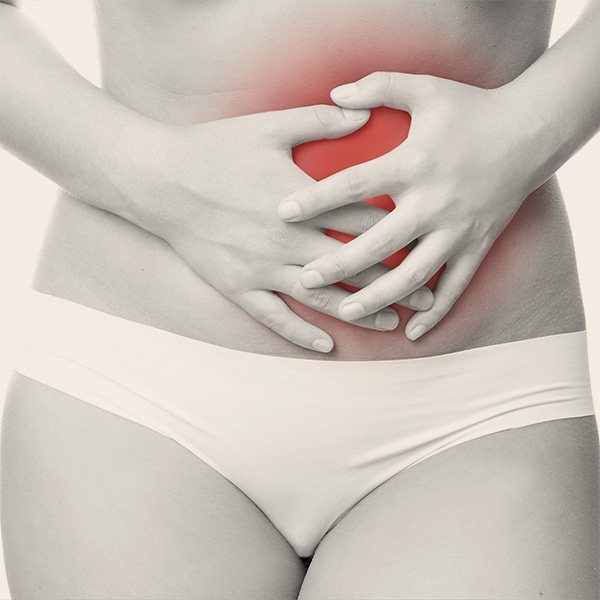
The pathological condition is characterized by numerous symptoms, including:
- pain in the epigastric zone and intestinal area;
- feeling of heaviness and fullness in the stomach;
- bowel dysfunction accompanied by constipation or diarrhea;
- increased gas formation;
- the presence of heartburn, belching, bad breath;
- decreased appetite.
Improper absorption of iron and vitamin B12 leads to anemia, resulting in weakness. In severe cases, skin problems may appear, hair loss, and nails may peel.
Sometimes the disease does not have pronounced symptoms, only discomfort in the stomach and abdominal cavity is noted. This condition requires additional examination to clarify the diagnosis.
Properly selected medications and diet help fight the disease. Treatment of atrophic gastritis with folk remedies gives good results; the most effective recipes are widely used as part of complex therapy for pathology.
When the disease occurs, nutrients are poorly absorbed, so patients experience nutritional deficiencies.
The need to adhere to a proper diet in case of pathology becomes of paramount importance. Its observance is aimed at stimulating the secretory function of the organ, reducing the intensity of fermentation processes in the intestines and enhancing the regeneration of damaged tissues of the stomach walls.
Medical nutrition is based on the following principles:
- The menu should be balanced and contain all the vitamins, minerals and other nutrients the body needs.
- Preference is given to easily digestible products that do not irritate or injure the mucous membrane.
- For nutrition, food with high energy value is used.
- Dishes with a high concentration of fiber, fried, smoked and canned foods are excluded from the diet.
- The menu is based on boiled or steamed dishes.
For atrophic gastritis, it is recommended to adhere to fractional meals.
List of useful products:
- low-fat soups;
- cereal porridge;
- boiled pasta;
- dietary meat of beef, turkey, chicken, rabbit;
- boiled eggs, steamed omelet;
- low-fat fish;
- vegetable oils;
- dried wheat bread and crackers;
- boiled or baked vegetables;
- non-acidic low-fat dairy products;
- diluted juices, compotes, jelly;
- weak tea;
- ripe sweet fruits;
- desserts: honey, jam, pastille, marmalade.
With atrophic gastritis, you should completely or partially limit the consumption of certain foods.

- legumes that promote increased gas formation;
- garlic, onions, radishes, radishes, hot seasonings and sauces, smoked foods that irritate the gastric mucosa;
- concentrated broths;
- fatty meats and fish;
- fresh bread or pastries, muffins, pancakes, cakes;
- animal fats;
- White cabbage;
- milk products with a high concentration of fat;
- carbonated drinks, strong tea, coffee, alcohol.
The dietary nutrition system leads to the normalization of the functions of the gastrointestinal tract and can be prescribed for a long period.
Natural ingredients that are available during therapy and safe for the body help improve or normalize the patient’s condition with pathology.
The herbal remedy stimulates the production of hydrochloric acid in the stomach, increases appetite and promotes better digestibility of food. Calamus rhizome contains a large amount of essential oils and ascorbic acid.
The medicinal composition is prepared according to the following recipes:
- 20 g of plant root are crushed and poured with half a glass of vodka. Leave for about 2 weeks. The product is filtered, squeezed out and placed in the refrigerator for storage. Use tincture 15 drops before meals.
- A medicinal composition is prepared with the addition of honey. For 15 g of root, take half a glass of bee product and 1 liter of cognac. The raw materials are poured with alcohol and infused for one and a half months. Strain, add honey and leave for another 30 days. Then the composition is placed in a cool place to “ripen” for 3 months. Use 5 ml twice a day before meals.
Thoroughly mix 50 g of St. John's wort, 10 g of flax seeds and yarrow herb and 25 g of plantain, peppermint, cumin seeds and angelica root. 1 tsp. prepared raw materials are poured with boiling water and left for 15 minutes.
The filtered drink is consumed hot 40-60 minutes before meals. Therapy is carried out until the patient's condition stabilizes.
To prepare the medicine, use 25 g of raw materials:
- meadow eyebright;
- St. John's wort;
- sweet clover;
- angelica rhizomes;
- mint;
- triads;
- sage;
- dill;
- wormwood.
1 tbsp. l. Thoroughly mixed ingredients are brewed with 200 ml of boiling water. Leave for 2-3 hours and filter. Used for treatment for 3 months. Dosage regimen: 1 glass of the product before meals. Compliance with a diet is a prerequisite for therapy.
In case of illness, it is useful to eat berries both fresh and frozen. Low temperatures do not affect its useful characteristics. And you should refrain from eating a product that has been subjected to heat treatment. Blueberry jam is not suitable for medicinal purposes.
The berry helps well with low acidity. It normalizes the functioning of the gastrointestinal tract and alleviates the patient's condition.
The introduction of fruit into the diet helps eliminate the inflammatory process in the stomach. The enveloping properties of banana have a positive effect on damaged areas of the epithelium and relieve irritation.
Eating 1 banana per day can relieve pain and stabilize the condition.
The product can be eaten both before and after meals.
Freshly squeezed juices have a positive effect on digestion. They provide a strengthening of the immune system. In some cases, a pasteurized product is more suitable for patients with atrophic gastritis.
For low acidity, tomato, apple or pomegranate juice is recommended. Increased acidity suggests using a potato or pumpkin drink. If the secretory function of the organ is normal, juice from beets or aloe is suitable.
The plant is an excellent remedy for stomach diseases. Using an infusion from the plant for 2-3 months leads to the elimination of unpleasant symptoms and normalization of the condition.
To prepare a therapeutic composition, 1 tsp. raw materials are poured with 250 ml of boiling water and left for 20-30 minutes. Apply 100 g before meals three times a day.
To improve the condition of a patient with atrophic gastritis, seasoning should be regularly added to dishes. You can also prepare a drink from the plant, which, when consumed systematically, gives good results. 1 tbsp. l. seeds are brewed with 500 ml of boiling water and left for 30 minutes. The product is drunk in the morning and evening.
Herbal medicine and medicinal foods should be used only after consultation with a specialist. For some pathological conditions, certain folk remedies are not recommended for treatment.
Their use must be carried out in strict compliance with dosages and preparation rules. Violation of the recommended standards can lead to complications.
source
Main signs of the disease
Signs of hypertrophic gastritis begin to appear as a result of the cessation of mucosal functions, and in some cases the disease is asymptomatic. The synthesis and functioning of substances that affect the concentration of pepsin and hydrochloric acid - prostaglandins - are disrupted. In most cases, clinical manifestations differ little from other forms of chronic disease.
The severity of the appearance depends on the stage of the pathology, age and immune status of the patients. The main symptom of hypertrophic gastritis is dyspepsia, which has symptoms similar to the erosive chronic form.
These include the following signs:
- heaviness in the stomach;
- hunger pain an hour after eating;
- pain in the polypous form (due to strangulation of the polyp);
- heartburn;
- belching food (smells like rotten eggs);
- bad taste in the mouth;
- less often – vomiting;
- diarrhea.
Severe deformations of the stomach tissues contribute to severe pain immediately after eating. Against this background, the patient’s appetite sharply decreases, exhaustion leads to weakness and weight loss. In the presence of erosions, bleeding is possible. Anemia develops, which is characterized by pale skin. The main distinguishing signs of hypertrophic pathology are tachycardia and shortness of breath.
These symptoms appear half an hour after eating. The stomach filled with gases and food puts pressure on the diaphragm, which causes shortness of breath. Intensive work of internal organs during digestion increases blood circulation, and as a result, heart rate increases.
It is important to know! The opinion that hypertrophic gastritis is a disease of adults is erroneous. In the practice of gastroenterologists, there have been cases of detection of pathology in children under 12 years of age.
Treatment of pathology
Treatment tactics directly depend on the stage of the pathology, as well as whether the person has other health problems. The treatment of granular gastritis is based on the use of a complex of special medications and a therapeutic diet.
In severe cases, surgery is indicated to stop the progression of the disease. In the remission stage, you can resort to traditional medicine recipes.
Drug treatment
In each individual case, the gastroenterologist selects the most appropriate set of medications. The choice of a particular medication depends on the patient’s condition, the presence of clinical manifestations of the disease and the severity of granular gastritis.
To treat the disease the following are used:
- anticholinergics or proton pump blockers - adjust the amount of hydrochloric acid produced;
- antacids - protect the gastric mucosa by enveloping it with a special film;
- absorbents - help remove rotting products in the stomach and other harmful substances from the body;
- correctors of the motor function of the organ - promotes better digestion in the stomach;
- enzymes - also improve digestion;
- antibiotics - prescribed for bacterial gastritis.
Without appropriate diagnosis and doctor's indications, it is prohibited to take any medications. Some medications can only worsen a person's condition over time, which may require surgical treatment.
Surgery
If drug therapy is ineffective or there are large hypertrophic areas, surgical intervention is prescribed. The operation can be performed by 2 methods: endoscopic or surgical.
The endoscopic method involves performing all therapeutic measures through three small punctures in the abdominal cavity, through which equipment for precise surgery is inserted. The surgical method is classic and is carried out through a cavity incision.
The choice in favor of one or another procedure is made not only by the patient, but also by the doctor, since each method has its own indications and contraindications.
Diet for granular gastritis
The patient will also be required to follow a diet for granular gastritis. The principles of nutrition are no different from medical recommendations for other forms of stomach inflammation. Meals should be regular, but fractional. It is better to divide the 3 main portions into several parts. You should avoid fried, salty, peppery, fatty, and heavy foods.
Basic principles of diet therapy:
- Preference should be given to a puree-like consistency. You should pay attention to vegetable cream soups. For the second course, you can prepare puree from boiled vegetables with lean stewed meat.
- The temperature of the food should not be cold or hot. Such food will cause unnecessary irritation of the gastric mucosa.
- Food needs to be handled very carefully. Snacks on the run are completely excluded.
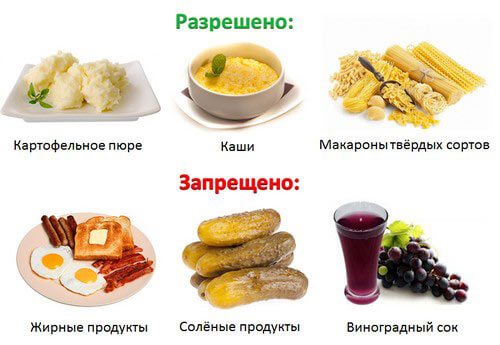
The diet for granular gastritis should be strict, but at the same time contain all the necessary vitamins, as well as micro- and macroelements. If there are problems with creating a menu, it is recommended to consult a nutritionist. This way, the chances of avoiding health problems are much higher.
Folk remedies
Traditional medicine must be treated with caution. Most products are harmful to the stomach, so you should consult your doctor before use.
Aloe juice has a healing effect, you can reduce acidity with freshly squeezed potato juice, and relieve pain with a light decoction of mint. High-quality vegetable oil has enveloping properties. It is important to remember that you need to take natural medicines on an empty stomach in the morning, half an hour before meals.
Diagnostic methods
In the early stages of hypertrophic gastritis, diagnosis is difficult. In an advanced form, with pronounced clinical signs, gastroenterologists make a primary diagnosis. After instrumental and laboratory tests, a final diagnosis is made and treatment for hypertrophic gastritis is prescribed.
One of the main studies is gastroscopy. Using this method, a superficial examination of the gastric mucosa is made and the extent of damage is determined. For a detailed study of the disease, the following methods are used:
- blood test (a reduced number of red blood cells indicates the development of anemia);
- targeted biopsy (sampling of mucosal tissue and histological examination of large areas of the surface);
- study of the secretory functioning of the stomach (carried out using a probe);
- microbiological method (study of mucosal cells in order to detect infection and the bacteria “Helicobacter pylori”).
An objective examination reveals characteristic signs - pain when palpating the abdomen, thick plaque on the teeth and tongue, cracks in the corners of the mouth. The results of radiological, endoscopic and histological studies are decisive. It is important for a specialist to distinguish hypertrophic gastritis from cancerous tumors.
In doubtful cases, the examination is repeated after 2–2.5 months and after the final diagnosis is made, treatment is prescribed. Therapeutic methods are aimed at relieving inflammation and restoring the epithelial function of the gastric mucosa.
Folk remedies
Treatment with folk remedies is also effective, provided that it occurs with an integrated approach.
Potato juice
It is possible to achieve a positive result from such therapy for this reason, because potato juice contains substances that have an enveloping effect on the gastric mucosa. Thanks to the regenerative properties of this product, it is possible to eliminate all erosions and ulcers. Read more about potato juice for gastritis.
To get the medicine, you need to take several fresh potatoes. Using a juicer, extract the juice and consume it in the amount of ½ cup. You should only use freshly squeezed product. This should be done 30 minutes before meals.
You can also drink the juice on an empty stomach every morning. Required quantity – 1 glass. After 1 hour you can eat food. The course of treatment will be 10 days.
Mineral water
The presented product has unique properties. Mineral water normalizes digestion, reduces acidity and suppresses the effects of hydrochloric acid.
The effect of mineral water depends on its temperature. If you need to reduce acidity, then you should consume the product warm. You should drink a glass of water at one time. Read more about mineral water for gastritis.
If gastric juice is secreted in insufficient quantities, then to activate its production it is necessary to drink cold mineral water. Required amount: ½ cup. Moreover, the reception is very slow.
Before drinking mineral water, you should get rid of gas bubbles in advance. This can be done using regular shaking. To speed up this process, it is recommended to heat the water. The duration of treatment will be 30 days.
Sea buckthorn oil
Sea buckthorn is one of the most effective treatments for hypertrophic gastritis. Sea buckthorn oil has a wound-healing, enveloping and anti-inflammatory effect. It should be used to heal ulcers and erosions. Take a dessert spoon before meals.
Flax seeds
This product is used as a decoction. With regular use you are guaranteed to get 100% results. Flax seeds have an enveloping effect, protect and restore the gastric mucosa. In order to prepare the product, you need to take a tablespoon of seeds, add hot water, and boil for 5 minutes. Leave for 2 hours. After the broth is filtered, it can be consumed one tablespoon before meals.
You can use this recipe: take one tablespoon at a time, add 500 ml of hot water, wait until the product infuses. Take the medicine one hour before meals. Required quantity: 250 ml.
Hypertrophic gastritis is one of the forms of chronic damage to the stomach. The disease is difficult to treat, but with an integrated approach it is still possible to overcome the symptoms that arise and alleviate the patient’s condition. It will not be possible to cure gastritis on your own; all actions taken must be agreed with a doctor.
Hypertrophic gastritis: symptoms and treatment with folk remedies
5 (100%) 1 vote(s)
Therapeutic methods
Nutritionists treat non-severe hypertrophic gastritis with conservative methods - chemical, biological, physical. They mainly use gentle nutrition with a high content of proteins and vitamins. Compliance with the rules of the diet for hypertrophic gastritis is crucial. Simple cooking recipes are used. Products must be fresh, thoroughly thermally processed.
Before consumption, food is ground and taken in small portions in liquid or puree form. During the treatment of hypertrophic gastritis, spicy, salty, sour, and pickled foods are removed from the patient’s diet.
Treatment with the following drugs has been successfully used:
- antibacterial (elimination of harmful bacteria);
- anticholinergics (reducing protein loss)
- astringent and enveloping (eliminating heartburn);
- painkillers (relieving pain attacks);
- enzymatic (to improve digestion);
- natural remedies - decoctions of flax seeds, oat seeds, plantain leaves, chamomile (for general strengthening of the body).
The complicated form of hypertrophic gastritis (incessant bleeding, pain, swelling) is eliminated through surgery. The overgrown tissue is removed, and the patient is monitored during the recovery period. Less often, if there is a threat to the patient’s life, a complete or partial “gastrectomy” is used - excision of the stomach.
In most cases, treatment prognosis is positive with strict adherence to the diet and doctor’s recommendations. A healthy lifestyle and complete cessation of bad habits - alcohol and smoking - contribute to long-term or complete remission. The disease is receding.
Source: gastrot.ru
Reasons for appearance
It is impossible to name the exact cause of granular gastritis. External causes of gastritis include, first of all, improper and irregular nutrition, alcohol and smoking abuse, and incorrect, excessively frequent and abundant intake of medications.

Internal causes include nervous fatigue, frequent stress, diseases of the endocrine system, critical deficiency of vitamins in the body. These include the development of pathogenic bacteria, infections and excessive exposure to radiation in very rare cases. There may be a hereditary predisposition to granular gastritis.
Concept
This gastritis is a type of acute inflammatory process affecting the mucous membranes of the stomach. The disease is characterized by pathological growth of the organ mucosa with the subsequent appearance of formations in the form of polyps and cysts on its surface.
Such deformation of the mucous membrane, according to generally accepted medical research, is benign in nature and, with timely treatment, does not pose a threat to human life. However, in the absence of treatment, the pathology develops rapidly, affecting the gastric mucosa on a more global scale. An advanced neoplasm in the future has a tendency to degenerate into a malignant tumor.
Important: Gastroenterologists warn that ignoring the first symptoms of the disease is completely unacceptable. Hypertrophic inflammation of the stomach can last for many years, subsequently transforming into an atrophic form of gastritis.
Antral and hyperplastic granular gastritis: treatment and diagnosis
The main danger of granular gastritis is the high risk of developing into cancer.
At the moment, experts identify several types of granular gastritis. They all differ in form, manifestations, and required treatment.
Granular gastritis has the following forms:
- antral: diagnosed in 30% of cases. The disease is characterized by the formation of large amounts of mucus and fluid in the stomach. The tone of the organ is significantly reduced, while the antrum is shortened and narrowed. The mucous membrane becomes swollen and contains about 90% of Helicobacter. At the same time, the antral form of granular gastritis is characterized by increased acidity. The duration of treatment is usually about 3 months;
- hyperplastic: the surface of the gastric mucosa is covered with numerous tubercles, the size of which does not exceed 1 millimeter. The folds of the organ themselves become coarsened, and foci of exacerbation spread to the posterior wall of the stomach and the antrum. The greatest danger of this disease is that it does not show any symptoms for a long time. Over time, a person begins to complain of nausea, heartburn, and belching.
The main danger of this disease is that granular gastritis may not manifest itself with any distinctive symptoms over a long period of time. The first signs of pathology appear already in advanced stages, when complications develop. As gastritis develops, it causes the formation of numerous erosions and cysts in the stomach.
Granular gastritis requires extensive diagnostics. For an initial examination, the doctor sends the patient for a general examination, after which he collects an anamnesis. Also, at the initial appointment, the specialist carefully palpates the abdomen and checks all internal organs. After this, radiography, fibrogastroscopy and esophagofibrogastroduodenoscopy are performed. It is very important to determine the level of stomach acidity. This is necessary to determine the correct treatment tactics.
It is very important to determine the level of stomach acidity. This is necessary to determine the correct treatment tactics
In order for the treatment of granular gastritis to be as effective as possible, it must be prescribed exclusively by a qualified attending physician. He will be able to do this solely on the basis of diagnostic data.
Typically, therapy for granular gastritis involves taking the following medications:
- antibiotics: suppress the activity of not only Helicobacter, but also other pathogenic microorganisms that arise in the stomach against the background of rotting;
- drugs that reduce the production of gastric juice;
- enzymes that improve the digestion process;
- antispasmodics, which relieve a person from painful sensations.
After the specialist manages to normalize the functioning of the stomach, medications are prescribed that accelerate the regeneration process. This is necessary to restore damaged mucosa, as well as relieve ulcers on the surface of the stomach.
Reasons for development
Adequate and correct treatment of hypertrophy can only be done if the cause of the disease is correctly established. The disease in most cases develops in a similar way to other forms of gastritis. However, this type of disease has its own individual characteristics and characteristics that fundamentally distinguish it from other types of inflammatory processes in the gastrointestinal tract.
The occurrence of the disease may be associated with the following factors:
- Infection with Helicobacter pylori is the main cause predisposing to the development of a pathological process in the stomach. This microorganism enters the human body along with poor quality and poorly processed food.
- Violation of the normal diet - a complete diet, which contains a sufficient amount of fiber, proteins, carbohydrates - is practically a guarantee of the absence of disease. However, frequent overeating or undereating, a poor and monotonous diet lead to the rapid appearance of an inflammatory process.
- Chronic hyperacidity of the stomach - an excessively acidic environment of the stomach predisposes to more active proliferation of pathogenic bacteria and microorganisms. Frequent stress, frequent use of spices and hot sauces, coffee, strong tea, and some medications predispose to increased acidity.
- The presence of Reflux - in this condition, a person experiences an involuntary reflux of stomach contents into the esophagus, which causes a lot of unpleasant sensations and at the same time negatively affects the condition of the digestive tract as a whole. The development of such a condition is predisposed by a person’s constant nervousness, stress, depression, and disruption of the autonomic nervous system.
Important: With hypertrophy, self-medication does not bring the expected results. The disease can reduce the intensity of its symptoms only for a short period of time. Then the symptoms resume with a vengeance.
Traditional methods of treating chronic gastritis
Recipes based on natural ingredients show good results with regular use. In addition to the drugs included in the TOP 5, there are other folk remedies that have shown their effectiveness in the treatment of chronic forms of stomach inflammation.
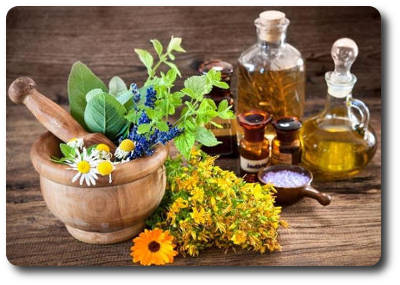
To reduce the unpleasant symptoms of hypoacid gastritis, experts recommend a diet that includes vegetable juices or fresh juices. In addition to their pleasant organic properties, drinks improve appetite, stimulate the motility of the digestive tract, and reduce nausea. Such drinks have medicinal qualities.
Cabbage juice
White cabbage stimulates the production of hydrochloric acid, promotes the healing of ulcers, and prevents their appearance. The useful liquid is obtained by grinding and squeezing the sheets. Drink 100-200 ml of juice 3 times a day one hour before meals. It is prescribed for hypoacid gastritis and erosive inflammation.
Beet juice
Fresh juice obtained from beets stimulates digestion, improves epithelial regeneration, reduces inflammation, and increases acidity in the stomach. The root vegetable is ground or grated on a fine grater. The solid part is squeezed out, the separated liquid is filtered through gauze or a fine sieve. You can use an electric juicer for preparation.
Important! Before use, the juice is allowed to stand for 120 minutes to eliminate volatile nitrogen compounds.
Take 1-2 teaspoons 3 times a day. Experts recommend mixing beetroot liquid with other types of fresh vegetable juices: cabbage, potato and carrot, in a 1:1 ratio. The product is effective for gastritis with low acidity.
carrot juice
The product reduces pain, restores the mucous membrane, reduces the inflammatory process, and is a source of vitamin A. The juice is obtained by processing the raw materials manually or using a juicer. Recommended 10 ml on an empty stomach for 2 weeks. Suitable for the treatment of various types of gastritis, given the neutral taste.
Attention! The maximum effect in the treatment of gastritis is observed with the use of a mixture of potato, beet and carrot juices.
The juice has anti-inflammatory, regenerating and bactericidal properties, reduces the secretion of hydrochloric acid. For treatment, use the leaves of a plant that is at least five years old. They are cut, washed and dried. After this, the thorns are cut off and the raw materials are crushed. Squeeze out the liquid part. Store in a dark place. Take 10 drops daily 30 minutes before meals. Various mixtures are also prepared with honey and other ingredients. This folk remedy helps cure focal and diffuse gastritis and eliminates Helicobacter pylori infection.
Celery
The plant juice is practically not used as monotherapy. The product increases the production of hydrochloric acid and promotes the healing of erosions. Raw materials are obtained in the same way as other types of juices. Celery is also used as an additional component of salads. Doctors recommend mixing it with other drugs. You can use celery for hyperacid and erosive gastritis.
Alcohol and alcohol tinctures
Ethyl alcohol is a good preservative for natural preparations, preserving their beneficial qualities. Therefore, if chronic gastritis is established, treatment with folk remedies includes the use of alcohol tinctures.
Mumiyo
The resin has a number of biological effects that have a positive effect on the entire body. With gastritis, inflammation decreases, erosions heal, and atrophic processes slow down. Prepare the tincture in a ratio of 1:10. Mumiyo is ground to a powder, poured with alcohol and infused for 2 weeks. Take 1-2 tablespoons 2 times a day. The remedy works for subatrophic, atrophic, erosive gastritis.
Propolis
The bee product has regenerating properties, reduces pain, and reduces acidity in the stomach. Propolis is mixed with alcohol in a 1:1 ratio and mixed thoroughly. Leave the mixture for 72 hours and filter. Take 10-15 drops 30 minutes before meals for 2 weeks. The method of treatment with propolis tincture is recommended for hyperacid conditions and the presence of ulcerative defects.
The rhizome of the plant is used to treat gastritis. The product is famous for its anti-inflammatory and healing qualities. 4 teaspoons of crushed raw materials are poured with 100 ml of alcohol. Drink 15-30 drops before meals 3 times a day. Used for inflammation of the stomach with low acidity, peptic ulcers, diarrhea, as well as in men for diseases of the genitourinary system.
Pure medical alcohol
Some people prefer pure alcohol as a remedy due to its bactericidal properties. However, gastroenterologists do not recommend this method, because when used, it can cause a burn to the mucous membrane of the esophagus and stomach. To eliminate erosions and eradicate Helicobacter pylori, take one teaspoon on an empty stomach 1.5 hours before meals and immediately eat a small piece of butter or a spoonful of honey.
Vegetables
Some vegetables are an excellent remedy for treating gastritis. Therefore, including them in the daily diet allows you to eliminate unpleasant symptoms and prevent the development of complications.
cucumbers
The fresh product stimulates the production of gastric juice, increases the motor function of the digestive system, and improves protein absorption. When the disease worsens, it is better to limit them. During the recovery process in a hypoacid state, you can eat cucumbers after peeling them.
Pumpkin
A storehouse of vitamins and nutrients. Consumed in the form of juice and thermally processed form. Reduces acidity, stimulates the outflow of bile, prevents reflux of bile into the stomach, eliminates dyspeptic symptoms. Recommended for gastritis with increased secretion and severe pain.
Lettuce
Use as a separate dish or as an addition to salads. The plant stimulates gastrointestinal motility and improves the production of hydrochloric acid. Lettuce can be added to the diet during inflammatory processes that are accompanied by a hypoacid state.
Animal products
Animal protein foods play an important role in the treatment and prevention of inflammation of the stomach, help normalize secretory function and restore the morphological structure of the organ.
Quail eggs
The hypoallergenic product contains vitamins and minerals necessary for metabolic processes. Raw quail eggs reduce mucus secretion, while the pH returns to normal after 20 minutes, have regenerating properties, and increase immunity. You need to take 1-2 pieces daily for 2 months. It is useful to take in case of hyperproduction of hydrochloric acid.
Goat milk
Milk eliminates pain, normalizes peristalsis, relieves inflammation, and reduces the aggressive effects of gastric juice. Useful for atrophic gastritis, given the enveloping effect and the large amount of cobalt necessary for the synthesis of vitamin B₁₂. Drink one glass 2 times a day for 3 weeks.
Oils
The special structure of oils allows them to be used to treat various forms of gastritis. The product is evenly distributed over the inner surface of the organ and has a positive effect on the mucous membrane.
Linseed oil
The healing effect is to reduce the irritating effect of mucus and relieve pain. Take 1 tablespoon daily on an empty stomach 1.5 hours before meals. Prescribed for gastritis with excess production of hydrochloric acid.
Olive
Olive oil protects the mucous membrane from the aggressive effects of gastric juice, accelerates the healing of erosions and ulcers, and prevents the development of reflux disease. Take 30 ml 2 times a day. The drug is used for hyperacid inflammation, erosive process and stomach ulcers.
Products of plant origin in the form of jelly
When processed, some plants produce mucus, which is very effective in treating gastritis. Kissels are prepared from flax seeds, oats, and bearberry. The substance coats the gastric mucosa and reduces signs of inflammation.
Bearberry
The plant has bactericidal and anti-inflammatory properties, reduces the likelihood of developing malignant tumors, and contains tannins. Half a glass of berries is mixed with 3 tablespoons of starch and 1 glass of water. The prepared jelly is cooled and taken chilled. A positive result is observed in the treatment of stomach pathology with excess production of hydrochloric acid.
Infusions
A popular dosage form is herbal infusions. They are convenient and safe to use. In the complex therapy of stomach diseases, a drug can be prepared based on one or a mixture of components.
Plantain
The plant has antiseptic, anti-inflammatory and astringent effects. One tablespoon of raw material is poured with boiling water and left for an hour. Take half a glass before meals 3 times a day. The product is effective for various forms of gastritis and peptic ulcers.
Thyme with mint
Flowers and leaves, fresh or dried, have an antitumor and bactericidal effect. The product is often combined with other herbs, especially mint. One tablespoon of the mixture is poured into 500 ml of boiling water. Infuse, strain and take throughout the day as tea. The product helps fight various types of gastritis.
A mixture of chamomile, celandine and St. John's wort
The collection helps fight pathogenic bacteria and the hyperacid gastritis that it causes. Celandine prevents the development of polyps on the gastric mucosa. Mix herbs in equal quantities, 1 tsp. The mixture is poured with a glass of boiling water and left for 2 hours. Take 1/2 cup 3 times a day. The medicine works effectively for polypous gastritis and inflammatory pathology with increased secretion of gastric juice.
Birch mushroom destroys pathogenic microorganisms and has antioxidant and tanning properties. 100 grams of chaga are poured into 1 liter of warm water to soften, and left for a day in a dark place. After straining, take 1/3 glass before meals 3 times a day for 14 days. A folk remedy eliminates spasms and is indicated for any stomach disease.
Dandelion root
The plant has anti-inflammatory properties and stimulates the secretion of gastric juice. One tablespoon of dry or fresh roots is poured with a glass of boiling water and left for 2 hours. Take the strained infusion 1/3 cup 2-3 times a day before meals. The recipe helps treat hypoacid pathology.
Symptoms and signs of the disease
Hypertrophic gastritis mainly occurs in people over 30 years of age. Most often, the pathology affects the muscle and mucous layer of the organ. In the folded areas, formations begin to form - cysts, adenomas, which can grow up to 2-3 centimeters in size. Rarely, formations increase to larger sizes.
Important: This disease can also occur in young children and adolescents. As a rule, this phenomenon is observed much less frequently.
The presence of the disease can be detected by the following signs:
- weight loss;
- characteristic aching pain in the epigastric region;
- heartburn;
- malaise;
- weakness;
- nausea;
- excessive salivation;
- vomiting (rare);
- intestinal dysfunction (constipation, diarrhea);
- feeling of heaviness in the stomach after eating;
- flatulence.
Important: The intensity of symptoms and its nature may vary in each individual case. The severity of the symptoms depends not only on the degree of neglect of gastritis, but also on the cause that caused its occurrence. Very often, patients confuse the manifestation of hypertrophic inflammation with ordinary gastritis.
Kinds
It is classified into several varieties. They are distinguished depending on the type of deformation and the behavior of the pathology:
| Pathology Menetrier | Characterized by the appearance of large folds on the surface of the mucous membranes of the stomach. Has a large area of inflammation. |
| Hypertrophic granular gastritis | Manifestation by the presence of multiple small formations - cysts on the surface of the mucous membranes of the organ. |
| Warty type of disease | Identified by detecting warty formations. |
| Polyposis type of disease | It is manifested by the appearance of polyps located in different parts of the organ mucosa. |
Important: Benign formations can be single, numerous, or located in separate groups. Taking this factor into account, optimally suitable and effective treatment is prescribed.
Varieties
With this disease, growths on the gastric mucosa can be single or multiple, sometimes they are located in groups. In medicine, it is customary to distinguish the following types of hypertrophic gastritis:
- Giant or Ménétrier's disease, which is characterized by the formation of huge folds on the gastric mucosa;
- Hypertrophic granular gastritis, caused by the appearance of different numbers of cysts in the form of small grains that limit the mobility of the folds;
- Warty gastritis - the formation of growths similar to warts;
- Polypous, characterized by the appearance of oval-shaped polyps of different sizes on the gastric mucosa;
- Erosive gastritis, characterized by damage in the form of erosions that appear as a result of an increase in the concentration of stomach acid or infection in the body.
In some medical sources that describe hypertrophic gastritis, the granular form is presented as the initial stage of the giant type or Menetrier's disease. This is due to the fact that the growth and thickening of the folds are similar, the only difference is in the depth of the lesion and the size of the tumors.
Some classifications distinguish the following types of disease:
- Focal, which has a limited pathological area;
- Diffuse, which is distributed over most of the mucous membrane;
- Superficial, affecting the upper layer of the gastric mucosa;
- Antral, suggesting the location of the pathology in the antrum of the organ.
Diagnosis and treatment
Before prescribing treatment, the patient must undergo a complete diagnostic examination. It includes the following mandatory measures:
Inspection
- taking anamnesis;
- palpation of the abdomen;
- examination of mucous membranes and skin for the presence of pathological changes, rashes, etc.
Instrumental research
- esophagofibrogastroduodenoscopy;
- biopsy;
- acidotest.
Analyzes
- coprogram;
- blood sampling;
- Analysis of urine;
- biochemistry.
Unfortunately, it is impossible to cure completely. However, when this disease occurs, symptomatic therapy is indicated, which is aimed at suppressing pain and normalizing the patient’s general condition.
A mild form of the disease requires outpatient treatment. The patient is prescribed the following treatment:
- Taking medications that reduce stomach acidity;
- Taking antacids;
- Use of blockers;
- Diet;
- No excessive physical activity.
If there is no result from such treatment, doctors decide on surgical intervention - removal of formations from the surface of the gastric mucosa.
After surgery, the patient should adhere to the following recommendations:
- Compliance with a strict, gentle diet, which involves taking mostly light and pureed food;
- No heavy lifting or strenuous exercise;
- Avoid nervous conditions and stressful situations.
Important: Following the diet during the postoperative period should last at least 6 months. You should also remember about the temperature of the food you eat - it should not be too cold or too hot.
Prognosis for recovery
With proper and timely treatment, the prognosis for recovery from hypertrophic gastritis is quite positive. However, it should be remembered that a complete cure for the disease is impossible. The patient may experience periods of exacerbations and remissions. Main. Avoid complications of the disease.
Source: netuyazvi.ru
Types of granular gastritis
Medicine classifies granular gastritis into a number of main forms. Let's look at each of them briefly.
Granular antral gastritis
Granular antral gastritis is the least common type, occurring in three out of ten cases. During an exacerbation, the patient experiences an abundance of mucus in the stomach, digestive disorders and narrowing of the antrum, severe swelling of the mucous membrane and increased acidity.
Granular hyperplastic gastritis
When suffering from granular hyperplastic gastritis, the patient develops small tubercles and the gastric folds become coarser. The posterior inner side of the stomach and the antrum are especially affected. The type develops asymptomatically and is manifested by heaviness in the stomach, increased frequency of heartburn attacks, and belching.
Types of hypertrophic gastritis
According to the degree of change in the mucous membrane, the following subtypes of hypertrophic gastritis are distinguished:
- granular form - with it cysts are found on the mucous membrane;
- polypous gastritis - polyps are found on the mucous membrane;
- warty hypertrophic gastritis - warts are detected on the mucous membrane;
- Ménétrier's disease - when large folds are found on the mucous membrane - there are three types (asymptomatic, pseudo-tumor, dyspeptic).
The listed growths are located in groups or individually. Based on localization, the disease is divided into focal and diffuse gastritis. In focal cases, damage occurs only in certain places of the mucous membrane. With diffuse, its entire surface is damaged.
Classification of gastritis
Hypertrophic gastritis is divided into several types, which are characterized by the duration and intensity of the development of the pathology. The main feature by which they can be combined is the transformation of the mucosal relief; it appears against the background of secretory insufficiency.
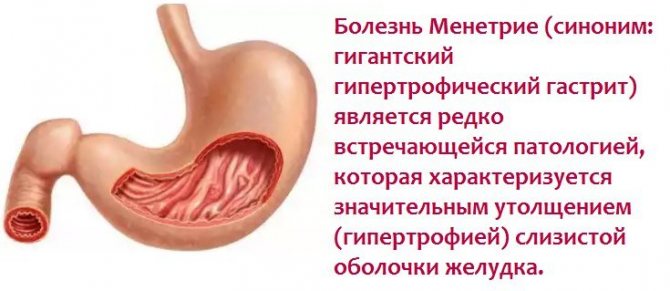
Under the influence of irritants, the gastric mucosa becomes inflamed and regenerates; these ongoing processes lead to the appearance of one of the types of hypertrophic gastritis:
- warty. A characteristic feature of this form is the presence of growths on the mucous membrane that resemble papillomas (warts) in appearance;
- giant gastritis (Menetrier's disease). With this type of gastritis, very large folds are present - up to 3 cm, atrophy of the secretory glands occurs, and the number of mucus-forming glands increases. This type of gastritis is divided into 3 forms: asymptomatic, pseudo-tumor, dyspeptic;
- granular form of gastritis. It is characterized by the formation of small (less than 1 cm) growths resembling grains. Pathological cavities appear inside the gastric walls, which are filled with liquid contents. This form of hypertrophic gastritis is formed against the background of the appearance of cysts of different types and sizes (from 2–3 mm to 1.5–2 cm);
- polypous form. It is typically characterized by the presence of both single and multiple growths (polyps) of connective tissue, which are formed as a result of increased regeneration (the size of the lesions is 0.5-2 cm in diameter).
Growths that form in the stomach can be of various types: benign or formations of a complicated inflammatory process. The hypertrophic process can penetrate into the parenchyma of the walls, that is, into the muscular layer of the digestive organ.
In addition, the pathology is divided into acute and chronic forms:
- The acute form is a dangerous pathology, due to the fact that the cause of its appearance is chemical intoxication. Penetration of caustic alkalis and acids into the gastrointestinal tract promotes deformation of the gastric walls and leads to tissue degeneration.
- The chronic form of gastritis is a sluggish pathology that has stages of exacerbation and remission.
Causes
The main causes of hypertrophic gastritis:
- poor nutrition;
- hereditary predisposition;
- disruptions in the hormonal system;
- abuse of bad habits;
- excess vitamins;
- chemical poisoning;
- stale food and many preservatives;
- reflux;
- bacterium Helicobacter pylori;
- stress;
- increased acidity.
Helicobacter pylori infection is found in almost all people, but not every one of them suffers from gastritis - the bacterium is not the cause of the disease. For the inflammatory process to occur, there must be other factors predisposing it. During its life, this bacterium produces substances that irritate the gastric mucosa, and additional synthesis of hydrochloric acid by the body begins. This leads to an increase in acidity, which is harmful to the mucous membrane, but beneficial for the bacteria itself.
Reflux is the improper movement of food through the digestive system, accompanied by the reflux of food from one organ to another (in the wrong sequence). For example, food can enter the stomach from the duodenum. This leads to bile entering the stomach, which corrodes the mucous membrane. If we take into account the increased acidity of the body, then it is not difficult to guess about the burns that arise on the walls of the organ.
Stress and emotional instability also provoke disorders of many organs. Initially, disturbances are observed in the autonomic nervous system, and then problems develop in other body systems, including the digestive system.
Symptoms
Chronic hypertrophic gastritis is usually found in adults rather than in children. Although in infants sometimes the disease also manifests itself. Symptoms resemble those of other forms of gastritis. The difference is the absence of symptoms at the initial stage of the disease. It is the latent flow that is fraught with danger. Hypertrophic gastritis is often mistaken for banal poisoning. The acute stage is detected quite quickly.
- Heartburn - with increased acidity and reflux.
- Nausea and vomiting, accompanied by copious amounts of saliva.
- Fast weight loss.
- Cutting pain in the stomach area.
- Lost appetite.
- Heaviness after eating.
- Bloating and flatulence.
- Bleeding in the stomach.
- Swelling on the face.
- Lethargy and weakness.
- Broken stool.
Diet for granular gastritis
If granular gastritis is caused by bacteria, antibiotics are used in treatment, but the main and main condition for recovery is diet. The regimen is prescribed taking into account many factors, such as acidity in the stomach and many others. Sometimes mineral waters obtained from natural sources are used. Typically, the course of treatment needs to be repeated periodically; it takes a month, but varies depending on the stage of advanced disease and the complications caused by it.
When eating food, you must chew it thoroughly without rushing. Food portions are minimal, food must contain vitamins, essential minerals and proteins, and be beneficial for the body. The optimal number of meals per day is five or six times. The temperature of the food is important - it does not need to be too hot, or, conversely, cold.
If we specify the list of products consumed when following a diet, then usually all kinds of flour products, fatty fish or meat dishes (including soups), canned foods, smoked, fried, salty and sweet foods are excluded from the diet. All kinds of carbonated drinks, strong tea or coffee are harmful. It is strongly recommended to avoid fruits with a sour taste (citrus fruits, grapes) and dark chocolate; it is not recommended to eat fresh, just baked bread. It is advisable to coordinate the addition of various dietary supplements to food, the use of medicinal tea and the use of traditional medicine with the attending physician.
The main diet of a patient with gastritis consists of various cereals, vegetable soups, and butter. Non-acidic dairy products, cheese, non-acidic compotes and fruit drinks from dried fruits, durum wheat pasta are welcome. Soft-boiled eggs, scrambled eggs and baked apples are suitable. It is possible to eat lean meat - chicken, beef and turkey. All products included in the patient’s diet have a delicate, non-sour taste. When preparing dishes, it is preferable to boil, stew or steam them.
It is strictly not recommended to create a diet for granular gastritis on your own; it is more prudent to use the qualified help of a nutritionist who has the necessary knowledge to competently create a diet, taking into account the stage of the disease, complications and characteristics of the patient.
Diagnostics
Typically, examination of the patient cannot reveal such diseases, except in cases of severe pain, when the person has to take a certain body position to avoid pain.
The initial examination by a doctor consists of taking an anamnesis, palpation of the abdomen and visual examination of the skin and mucous membranes. With palpation, you can assess in which part the pain is localized. With gastritis, unpleasant sensations are observed in the epigastric area.
Using EGD, the acidity of gastric juice is determined. During the procedure, bile and mucous membrane samples are taken. The obtained materials are examined for the presence of pathogenic microflora. There are cases when it is impossible to carry out the FGDS procedure - for example, if the patient constantly vomits when swallowing the hose. In such situations, an acid test is performed. The patient takes 2 tablets of the drug and after a while gives urine for analysis. Based on the acidity of the collected urine, you can roughly estimate the acidity in the stomach.
There are several methods for identifying the bacterium Helicobacter pylori:
- breath test - it can be used to estimate the percentage of bacterial production products in the patient’s body due to the use of a drug with labeled carbon atoms;
- FGS - a device is used that allows you to examine the mucous membrane and visualize its condition;
- stool analysis - the presence of antigen to bacteria in the patient’s body is assessed.
Treatment
A mild form of hypertrophic gastritis can be treated on an outpatient basis. In the acute form of the disease, therapy is prescribed depending on the symptoms. To reduce the amount of pain, medications are prescribed that reduce acidity. This ensures not only a normal level of acidity, but also avoids damage to the mucous membrane due to increased acid activity. Such drugs include receptor blockers and antacids.
Antacids are usually available in the form of syrup or gel - this form allows you to envelop the gastric mucosa, further protecting it from damage. Antibiotics are used to destroy pathogenic flora.
In cases where standard methods are ineffective, surgical intervention is resorted to - depending on the degree of damage to the organ - either removal of the resulting growths or resection of part of the stomach.
The most important thing is not to forget about the diet, since without proper nutrition the result of any treatment will gradually fade away. You will have to give up junk food and alcohol and cigarettes. All bad habits negatively affect our body, including the digestive tract. Food should be taken often in small portions. Eliminate all kinds of stress and give the body rest - so it can recover on its own.
ethnoscience
To treat hypertrophic gastritis, you can also use folk remedies. But you should approach such methods with caution, as they can negatively affect other organs and systems. Be sure to consult a specialist.
With increased acidity, the patient can benefit from herbal decoctions (chamomile, St. John's wort, nettle). In case of low acidity, cabbage juice is useful. It is better to take it warm (room temperature).
Flax seeds will have an enveloping effect if you make a decoction of them.
Therapeutic treatment
Like most other diseases, granular gastritis is much easier to cure in the early stages, so if symptoms are detected or become more frequent, it is not recommended to postpone a visit to the doctor. Otherwise, episodic attacks can turn into chronic granular gastritis with many complications; treatment is expected to take significantly longer and is much more difficult, both for the gastroenterologist and nutritionist, and for the patient himself.
During the therapeutic course, the patient needs to give up bad habits, such as addiction to alcohol and smoking abuse. It is recommended to avoid stress and overexertion, normalize your daily routine, alternate work and rest, sleep at least eight hours a day, and exercise whenever possible. It is advisable to avoid fried, spicy and fatty foods.
If we talk about traditional medicine, then for granular gastritis, herbal medicine, which consists in the use of medicinal herbs, plants and berries, will have a healing effect.
Treatment of granular gastritis is prescribed only by an experienced gastroenterologist, taking into account all factors and contraindications for the use of drugs. It is strongly not recommended to treat gastritis without prior consultation with a professional; this leads to the development of multiple complications and aggravation of the symptoms of the disease.
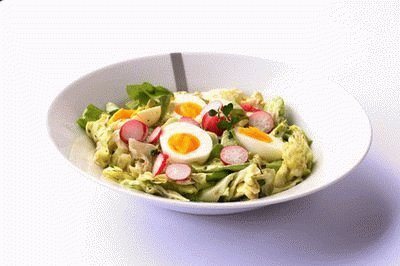
In addition to diet, in the treatment of this type of gastritis, antibiotics and, in some cases, enzyme substances that have a beneficial effect on digestion are used. At the beginning of treatment, the patient takes antibiotics that suppress the growth rate of harmful bacteria, and medications that regulate gastric secretions. The analgesic effect during acute attacks is provided by antispasmodic drugs. Later, in the second stage of therapy, drugs are used that restore metabolism in the stomach and help regenerate the lining of its walls.
If therapeutic treatment is ineffective, surgical intervention is used; during the procedure, grain-like growths are removed from the inner walls of the stomach.
Diet
Eliminate fried foods from your diet, as well as highly salty and spicy foods. You will have to give up many dishes - sweet and salty, smoked and fatty. All these types of dishes have a detrimental effect on the mucous membrane. Strong hot coffee, soda, and energy drinks have an irritating effect.
If you do not follow the right diet, you can develop complications of the disease, including cancer!
It is best to boil or mash dishes - this way they are better absorbed. An apple is very useful, although during an exacerbation it is better to eat it only baked.
Prognosis and prevention
The disease is not cured quickly - you will have to be patient. But if you follow a diet, take prescribed medications and, as an addition, use traditional methods approved by your doctor, then the disease will subside. Otherwise, bleeding in the stomach may develop, sometimes leading to the death of the patient. As a preventive measure, eat right, lead a healthy lifestyle, and treat all diseases of the digestive system in a timely manner.
Source: uvasgastrit.ru



